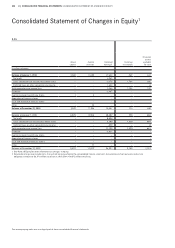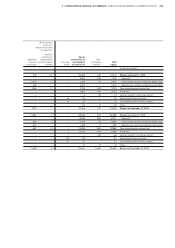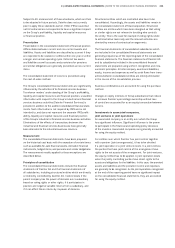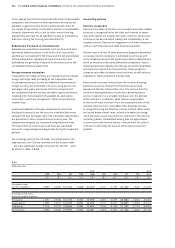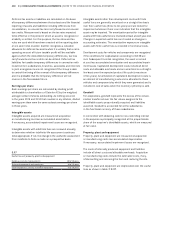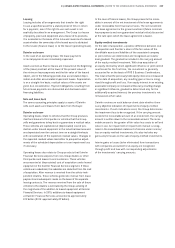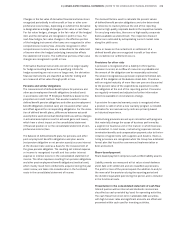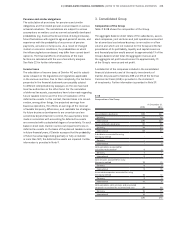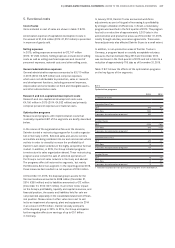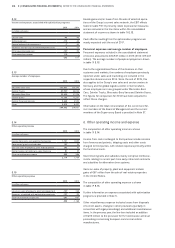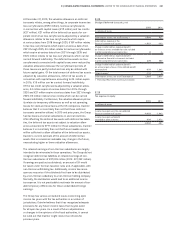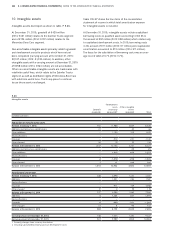Mercedes 2015 Annual Report Download - page 205
Download and view the complete annual report
Please find page 205 of the 2015 Mercedes annual report below. You can navigate through the pages in the report by either clicking on the pages listed below, or by using the keyword search tool below to find specific information within the annual report.212 E | CONSOLIDATED FINANCIAL STATEMENTS | NOTES TO THE CONSOLIDATED FINANCIAL STATEMENTS
If, in a subsequent reporting period, the amount of the
impairment loss decreases and the decrease can be attributed
objectively to an event occurring after the impairment was
recognized, the impairment loss recorded in prior periods is
reversed and recognized in profit or loss.
In most cases, an impairment loss on loans and receivables
(e.g. receivables from financial services including finance
lease receivables and trade receivables) is recorded using
allowance accounts. The decision to account for credit
risks using an allowance account or by directly reducing the
receivable depends on the estimated probability of the
loss of receivables.
Available-for-sale financial assets. If an available-for-sale
financial asset is impaired, the difference between its cost
(net of any principal payment and amortization) and its current
fair value (less any impairment loss previously recognized
in the statement of income) is reclassified from other compre-
hensive income/loss to the statement of income. Reversals
with respect to equity instruments classified as available for
sale are recognized in other comprehensive income/loss.
Reversals of impairment losses on debt instruments are recog-
nized through the statement of income if the increase in fair
value of the instrument can be objectively attributed to an event
occurring after the impairment losses were recognized in
the consolidated statement of income.
Offsetting financial instruments
Financial assets and financial liabilities are offset and the net
amount is presented in the consolidated statement of financial
position provided that an enforceable right currently exists
to offset the amounts involved, and there is an intention either
to carry out the offsetting on a net basis or to settle a liability
when the related asset is sold.
Financial liabilities
Financial liabilities primarily include trade payables,
liabilities to banks, bonds, derivative financial liabilities and
other liabilities.
Financial liabilities measured at amortized cost. After initial
recognition, financial liabilities are subsequently measured
at amortized cost using the effective interest method.
Financial liabilities at fair value through profit or loss. Financial
liabilities at fair value through profit or loss include financial
liabilities held for trading. Derivatives, (including embedded
derivatives separated from the host contract) which are
not used as hedging instruments in hedge accounting, are
classified as held for trading. Gains or losses on liabilities
held for trading are recognized in profit or loss.
Derivative financial instruments and hedge accounting
The Group uses derivative financial instruments exclusively
for hedging financial risks that arise from its commercial
business or refinancing activities. These are mainly interest
rate risks, currency risks and commodity price risks.
Embedded derivatives are separated from the host contract,
which is not measured at fair value through profit or loss,
if an analysis shows that the economic characteristics and
risks of embedded derivatives are not closely related to
those of the host contract.
Derivative financial instruments are measured at fair value
upon initial recognition and at each subsequent reporting date.
The fair value of listed derivatives is equal to their positive
or negative market value. If a market value is not available, fair
value is calculated using standard financial valuation models
such as discounted cash flow or option pricing models. Deriva-
tives are presented as assets if their fair value is positive and
as liabilities if the fair value is negative.
If the requirements for hedge accounting set out in IAS 39 are
met, Daimler designates and documents the hedge relation-
ship from the date a derivative contract is entered into as a fair
value hedge, a cash flow hedge or a hedge of a net investment
in a foreign business operation. In a fair value hedge, the fair value
of a recognized asset or liability or an unrecognized firm com-
mitment is hedged. In a cash flow hedge, the variability of cash
flows to be received or paid from expected transactions related
to a recognized asset or liability or a highly probable forecast
transaction are hedged. The documentation of the hedging
relationship includes the objectives and strategy of risk manage-
ment, the type of hedging relationship, the nature of the risk
being hedged, the identification of the hedging instrument and
the hedged item, as well as a description of the method used
to assess hedge effectiveness. Hedging transactions are
expected to be highly effective in achieving offsetting risks from
changes in fair value or cash flows and are regularly assessed
to determine that they have actually been highly effective
throughout the financial reporting periods for which they are
designated.


